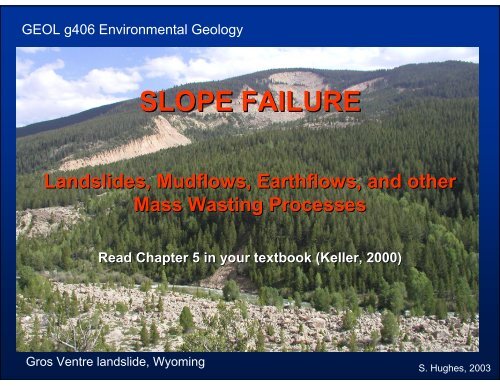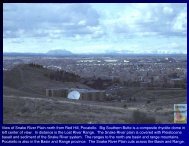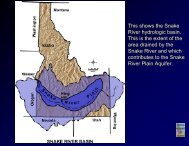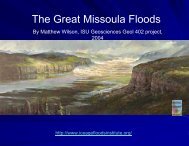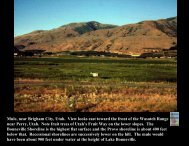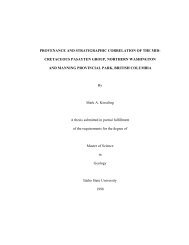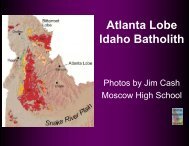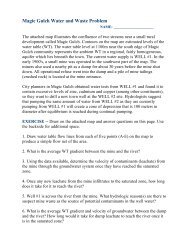larger file size version in PDF format
larger file size version in PDF format
larger file size version in PDF format
You also want an ePaper? Increase the reach of your titles
YUMPU automatically turns print PDFs into web optimized ePapers that Google loves.
GEOL g406 Environmental Geology<br />
SLOPE FAILURE<br />
Landslides, Mudflows, Earthflows, and other<br />
Mass Wast<strong>in</strong>g Processes<br />
Read Chapter 5 <strong>in</strong> your textbook (Keller, 2000)<br />
Gros Ventre landslide, Wyom<strong>in</strong>g<br />
S. Hughes, 2003
• There are many types of slope failure.<br />
• Slope failure, also referred to as mass wast<strong>in</strong>g, is the<br />
downslope movement of rock debris and soil <strong>in</strong> response<br />
to gravitational stresses. Three major types of mass<br />
wast<strong>in</strong>g are classified by the type of downslope<br />
movement: falls, slides, and flows.<br />
• In addition,<br />
another type<br />
of ground<br />
failure:<br />
subsidence,<br />
is important<br />
to human<br />
existence.<br />
Halemaumau Pit Crater, Kilauea<br />
S. Hughes, 2003
SLOPES<br />
• Material is constantly mov<strong>in</strong>g downslope <strong>in</strong> response to<br />
gravity. Movement can be very slow, barely perceptible<br />
over many years.<br />
• Or, movement can be devastat<strong>in</strong>gly rapid, apparent with<strong>in</strong><br />
m<strong>in</strong>utes. Whether or not slope movement occurs depends<br />
on slope steepness and slope stability.<br />
SLOPE PROFILE<br />
• Some slopes are gently rounded, while others are<br />
extremely steep. Pro<strong>file</strong>s of naturally-eroded slopes are<br />
primarily dependent on climate and rock type.<br />
GEOL g406 Environmental Geology S. Hughes, 2003
Common Slope Elements<br />
Figure from Keller (2000)<br />
Slopes common <strong>in</strong> semiarid<br />
regions or on rocks resistant<br />
to weather<strong>in</strong>g and erosion.<br />
Convex-concave slopes<br />
common <strong>in</strong> semihumid<br />
regions or <strong>in</strong> areas with<br />
relatively soft rocks.<br />
GEOL g406 Environmental Geology S. Hughes, 2003
MASS WASTING PROCESSES<br />
Flowage, or flow = downslope<br />
movement of unconsolidated material.<br />
Particles move around and mix with<br />
the mass.<br />
Figure from Keller (2000)<br />
Slid<strong>in</strong>g = downslope movement of a<br />
coherent block of earth material.<br />
Fall<strong>in</strong>g = free fall of earth material, as<br />
from a cliff, the free face of a slope.<br />
Subsidence = s<strong>in</strong>k<strong>in</strong>g of a mass of<br />
earth material below the surround<strong>in</strong>g<br />
ground level; can occur on slopes or<br />
on flat ground.<br />
GEOL g406 Environmental Geology S. Hughes, 2003
MASS WASTING PROCESSES<br />
Common type of<br />
landslide consist<strong>in</strong>g<br />
of an upper slump<br />
motion and a lower<br />
flow.<br />
Upper slump<br />
Lower flow<br />
Figure from Keller (2000)<br />
GEOL g406 Environmental Geology S. Hughes, 2003
Read Table 6.1 <strong>in</strong> Keller (2000)<br />
Type of Movement<br />
Material Involved<br />
ROCK<br />
SOIL<br />
Falls rockfall soilfall<br />
Slides<br />
Rotational rock slump block slump block<br />
Translational rock slide debris slide<br />
Flows<br />
Slow rock creep soil creep<br />
earthflow<br />
mudflow<br />
debris flow<br />
Fast<br />
debris avalanche<br />
Complex<br />
comb<strong>in</strong>ations of slides and flows<br />
GEOL g406 Environmental Geology S. Hughes, 2003
SLOPE STABILITY<br />
• When is a slope not stable?<br />
• Slope stability is based on the <strong>in</strong>terplay between two<br />
types of forces:<br />
driv<strong>in</strong>g forces and resist<strong>in</strong>g forces.<br />
• Driv<strong>in</strong>g forces promote downslope movement of<br />
material.<br />
• Resist<strong>in</strong>g forces deter movement.<br />
• When driv<strong>in</strong>g forces overcome resist<strong>in</strong>g forces, the slope<br />
is unstable and results <strong>in</strong> mass wast<strong>in</strong>g.<br />
• The ma<strong>in</strong> driv<strong>in</strong>g force <strong>in</strong> most land movements is<br />
gravity.<br />
• The ma<strong>in</strong> resist<strong>in</strong>g force is the material's shear strength.<br />
GEOL g406 Environmental Geology S. Hughes, 2003
DRIVING FORCES<br />
Gravity: Does gravity act alone? NO!! Slope angle,<br />
climate, slope material, and water contribute to the effect of<br />
gravity. Mass movement occurs much more frequently on<br />
steep slopes than on shallow slopes.<br />
Water plays a key role <strong>in</strong> produc<strong>in</strong>g slope failure. In the<br />
form of rivers and wave action, water erodes the base of<br />
slopes, remov<strong>in</strong>g support, which <strong>in</strong>creases driv<strong>in</strong>g forces.<br />
Water can also <strong>in</strong>crease the driv<strong>in</strong>g force by load<strong>in</strong>g, i.e.,<br />
add<strong>in</strong>g to the total mass that is subjected to the force of<br />
gravity. The weight (load) on the slope <strong>in</strong>creases when<br />
water fills previously empty pore spaces and fractures.<br />
An <strong>in</strong>crease <strong>in</strong> water contributes to driv<strong>in</strong>g forces that<br />
result <strong>in</strong> slope failure.<br />
GEOL g406 Environmental Geology S. Hughes, 2003
RESISTING FORCES<br />
Resist<strong>in</strong>g forces act oppositely of driv<strong>in</strong>g forces.<br />
The resistance to downslope movement is dependent on<br />
the shear strength of the slope material. And shear<br />
strength is a function of cohesion (ability of particles to<br />
attract and hold each other together) and <strong>in</strong>ternal friction<br />
(friction between gra<strong>in</strong>s with<strong>in</strong> a material).<br />
Chemical Weather<strong>in</strong>g (<strong>in</strong>teraction of water with surface<br />
rock and soil) slowly weakens slope material (primarily<br />
rock), reduc<strong>in</strong>g its shear strength, therefore reduc<strong>in</strong>g<br />
resist<strong>in</strong>g forces.<br />
IMPORTANT: The shear strength of the slope material is<br />
decreased by <strong>in</strong>creas<strong>in</strong>g the pore water pressure<br />
(pressure that develops <strong>in</strong> pore spaces due to the<br />
<strong>in</strong>creased amount of water).<br />
GEOL g406 Environmental Geology S. Hughes, 2003
SLOPE STABILITY<br />
Safety Factor (SF) = The ratio of resist<strong>in</strong>g forces<br />
to driv<strong>in</strong>g forces:<br />
Resist<strong>in</strong>g Forces<br />
SF =<br />
Driv<strong>in</strong>g Forces<br />
If SF > 1 then SAFE<br />
If SF < 1 then UNSAFE<br />
NOTE: A safety factor of ~1.25 or somewhat higher is<br />
acceptable for slope stability. A safety factor of ~10 is<br />
often used <strong>in</strong> build<strong>in</strong>g design to accommodate slight<br />
variances <strong>in</strong> materials and construction practices.<br />
GEOL g406 Environmental Geology S. Hughes, 2003
SLOPE STABILITY<br />
W = Weight of total mass of earth material (at center of mass).<br />
D = Vector component of W parallel to potential movement.<br />
N = Vector component of W normal to slip plane.<br />
GEOL g406 Environmental Geology S. Hughes, 2003
SLOPE STABILITY<br />
GEOL g406 Environmental Geology S. Hughes, 2003
N<br />
C<br />
W<br />
D<br />
A<br />
Potential slip plane<br />
(clay).<br />
ROCK<br />
SLOPE STABILITY<br />
Calculate the safety factor<br />
us<strong>in</strong>g D to obta<strong>in</strong> driv<strong>in</strong>g force<br />
and N to obta<strong>in</strong> resist<strong>in</strong>g force.<br />
This is a simplified example, so<br />
the clay layer is assumed to<br />
have constant <strong>in</strong>ternal friction,<br />
i.e., the shear strength is the<br />
same everywhere, when wet.<br />
D = W s<strong>in</strong> A = driv<strong>in</strong>g force<br />
• the downslope component of gravity.<br />
N = W cos A = the normal component of W<br />
• contributes to the shear strength along the slip plane<br />
• contributes to the resist<strong>in</strong>g force.<br />
GEOL g406 Environmental Geology S. Hughes, 2003
SLOPE STABILITY<br />
The safety factor <strong>in</strong>volv<strong>in</strong>g a clay layer may be calculated<br />
by the unit thickness method us<strong>in</strong>g the follow<strong>in</strong>g<br />
equation:<br />
SF = SLT/W s<strong>in</strong> A<br />
EXAMPLE<br />
S = shear strength of the clay layer 9x10 4 N/m 3<br />
L = length of the slip plane<br />
50 m<br />
T = unit thickness (assume 1)<br />
1 m<br />
W = area (500 m 2 ) x thickness (1 m) x<br />
unit weight (1.6x10 4 N/m 3 )<br />
8x10 6 N<br />
A = 30º, s<strong>in</strong> A = 0.5 0.5<br />
SF = 1.125 (conditionally stable)<br />
Can you th<strong>in</strong>k of examples where this can be applied?<br />
GEOL g406 Environmental Geology S. Hughes, 2003
Ground material affects the pattern of<br />
slope failure:<br />
Type # 1 Homogeneous material leads to<br />
rotational failure.<br />
GEOL g406 Environmental Geology S. Hughes, 2003
Ground material affects the pattern of<br />
slope failure:<br />
Type # 2 Material with planes of weakness<br />
leads to translational failure.<br />
GEOL g406 Environmental Geology S. Hughes, 2003
Figure from Keller (2000)<br />
Ground material<br />
affects the<br />
pattern of slope<br />
failure:<br />
Type # 3 Rock<br />
and colluvium slope<br />
leads to soil slip<br />
failure.<br />
NOTE: There are actually only two types of failure<br />
patterns, rotational and translational. Shallow soil slip is<br />
also a type of translational movement.<br />
GEOL g406 Environmental Geology S. Hughes, 2003
FLOWS<br />
Flows are the downslope movement of unconsolidated<br />
material <strong>in</strong> which the material behaves like a viscous fluid.<br />
Flows can be very slow or can be exceed<strong>in</strong>gly fast.<br />
Creep a type of flow<br />
Example: trees on a slope<br />
where the base of each tree<br />
bows outward <strong>in</strong> the<br />
downslope direction<br />
What other examples can<br />
you see <strong>in</strong> daily life?<br />
GEOL g406 Environmental Geology S. Hughes, 2003
EFFECT OF WATER<br />
Perched water table decreases slope stability by caus<strong>in</strong>g<br />
temporary <strong>in</strong>crease <strong>in</strong> pore water pressure which reduces<br />
shear strength <strong>in</strong> the earth material.<br />
Figure from Keller (2000)<br />
Colluvial soil;<br />
relatively<br />
permeable.<br />
Bedrock;<br />
low permeability.<br />
GEOL g406 Environmental Geology S. Hughes, 2003
Influence of TIME on the development of a landslide:<br />
progressive creep (left) and progressive wett<strong>in</strong>g (right).<br />
Rate of Creep<br />
Safety Factor<br />
3<br />
2<br />
1<br />
3<br />
2<br />
1<br />
Time<br />
FAILURE<br />
Safety Factor<br />
3<br />
2<br />
1<br />
Road fill<br />
Culvert<br />
Wett<strong>in</strong>g events<br />
4<br />
2<br />
3<br />
1<br />
FAILURE<br />
Soil<br />
Rock<br />
Wett<strong>in</strong>g events<br />
FAILURE<br />
Water<br />
Time<br />
1 2 3 4<br />
Time<br />
GEOL g406 Environmental Geology S. Hughes, 2003
SUBSIDENCE<br />
Depression the result of subsidence. By def<strong>in</strong>ition,<br />
subsidence is the very slow to rapid s<strong>in</strong>k<strong>in</strong>g or settl<strong>in</strong>g of<br />
the land surface.<br />
Subsidence can be the result of natural causes.<br />
Some type of carbonate rock underlies topography<br />
conta<strong>in</strong><strong>in</strong>g numerous natural depressions, known as<br />
s<strong>in</strong>kholes. The topography is known as karst topography.<br />
Limestone and dolomite, both carbonate rocks, are soluble<br />
and susceptible to chemical weather<strong>in</strong>g. Chemical<br />
weather<strong>in</strong>g produces void spaces (very very small to<br />
cavernously large). S<strong>in</strong>kholes result when enough<br />
"support" has been removed from the carbonate layer. The<br />
surface then collapses <strong>in</strong>to the void space, produc<strong>in</strong>g a<br />
s<strong>in</strong>khole.<br />
GEOL g406 Environmental Geology S. Hughes, 2003
Reta<strong>in</strong><strong>in</strong>g Wall<br />
Used to help stabilize a roadcut<br />
Figure from Keller (2000)<br />
GEOL g406 Environmental Geology S. Hughes, 2003
Landslide near Dam<br />
Figure from Keller (2000)<br />
GEOL g406 Environmental Geology S. Hughes, 2003
Landslide on Road<br />
GEOL g406 Environmental Geology S. Hughes, 2003
Landslide on Hillside Development<br />
GEOL g406 Environmental Geology S. Hughes, 2003
Avalanche<br />
Figures from Keller (2000)<br />
GEOL g406 Environmental Geology S. Hughes, 2003
S<strong>in</strong>khole <strong>in</strong> Karst Topography<br />
GEOL g406 Environmental Geology S. Hughes, 2003


